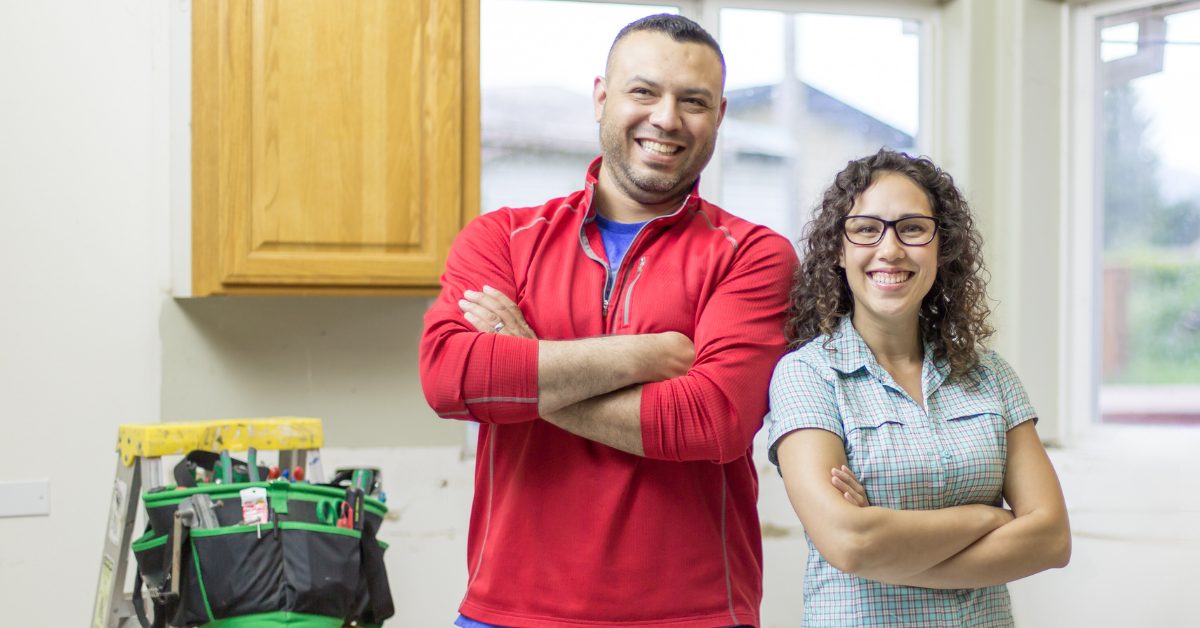Those frustratingly high energy bills. The drafty rooms that always feel uncomfortable. Knowing you could be doing more for the environment.
If this sounds familiar, a home energy audit might be just what you need.
Why Bother with a Home Energy Audit?
You might be thinking, “a home energy audit sounds good, but…” Let’s be honest – crawling around the attic or poking into dark corners doesn’t exactly scream “fun weekend project.”
Plus, what if you find something wrong? It’s natural to feel a little hesitant, or maybe even overwhelmed by the whole idea. And hey, we all have busy lives!
But before you push the idea aside, let’s bust through those worries and show you why a DIY audit is absolutely worth the effort.
Solving the Mystery of High Energy Bills
An audit pinpoints the exact reasons behind them. You’ll learn where money is being wasted and discover targeted solutions to bring those costs down.
Go Green and Save Green
Every bit of energy saved reduces your reliance on polluting sources. By making your home more efficient, you’ll directly contribute to a healthier planet and lower your energy costs.
Comfort is Key
Say goodbye to drafty rooms, uneven temperatures, and a home that never feels quite right. An audit reveals the fixes you need for year-round comfort.
Don’t Renovate Blind
If you’re planning a major renovation, an audit beforehand is like getting an X-ray of your home. It shows you where to focus your renovation dollars for the biggest energy-saving impact.
Gear Up for Your Energy Investigation!
Before you start uncovering your home’s energy secrets, here’s what you’ll need:
- Flashlight: Your trusty tool for illuminating dark corners, like your attic or behind appliances, where energy waste might be hiding.
- Notepad and pen: Every good detective takes notes! You’ll want to jot down everything you find, from drafty windows to outdated appliances.
- Incense stick (or thermal leak detector – optional): These tools help you pinpoint the exact location of sneaky air leaks.
- Past year’s utility bills: These are your baseline. After fixing the problems you find, you can compare and see how much you’re saving!
Step 1: Hunt Down the Big Energy Users
Where does all that energy go? Let’s start by tracking down the places where it might be escaping in your home.
Heating & Cooling Central
Filter Check: Your furnace and AC work like your lungs, drawing in air and circulating it. A clean filter is like breathing freely! Check your unit’s manual for how often to replace the filter. A clean filter makes your system more efficient and even improves your indoor air quality.
Insulation Inspection: Think of insulation like a warm blanket for your home. Check your attic, basement, or crawlspaces. Is the insulation missing in spots, looking old, or too thin? Proper insulation keeps your home comfortable year-round, so your heating and cooling system doesn’t have to work overtime.
Eco-Tip: Good insulation makes a dramatic difference! By preventing heat from escaping (or sneaking in during summer), you help the environment by reducing the demand on your heating and cooling systems.
The Water Heater Check
The Touch Test: Does your water heater feel warm when you touch it? That means heat is escaping from the tank—and that’s wasted energy. Adding a water heater insulation blanket can help keep the heat where it belongs.
Age Matters: Older water heaters often aren’t as efficient as modern ones. Jot down the age of yours. If it’s getting old, you might want to start researching newer models.
Eco-Tip: Remember, heating water takes energy! An efficient water heater that doesn’t lose heat helps you save money and lessens your environmental impact.
Appliance Sleuthing
Age and Ratings: Check the age and look for an Energy Star label on your big appliances (like your refrigerator, washer, dryer, dishwasher). Older appliances can be real energy hogs, even if they are working fine.
Step 2: Track Down Air Leaks
These sneaky drafts can drive up your energy bills and make your home less comfortable. Here’s how to find them:
Windows & Doors:
Draft Detective
You can use a lit incense stick or a thermal leak detector for this. Here’s how to use an incense stick to detect air leaks in your home:
- Avoid windy days when natural air movement might interfere with your results.
- Shut all exterior windows and doors except for the one you’re currently checking.
- Temporarily turn off your furnace, AC, and any exhaust fans to minimize other airflow in the house.
- Light the end of your incense stick until it produces a steady stream of smoke.
- Slowly move the lit incense stick around the edges of windows, doors, outlets, baseboards, and any other areas where you suspect a leak.
- If the smoke wavers, gets sucked inward, or blows away in a specific direction, you’ve found a draft! Mark the spot for sealing later.
Easy Fixes: Most drafts around windows and doors can be fixed with weatherstripping or caulk. These are simple DIY projects that make a noticeable difference.
Don’t Forget the Damper: When your fireplace isn’t in use, double-check that the damper is fully closed. An open damper allows warm (or cool) air to escape directly outside.
Eco-Tip: Air sealing significantly reduces the amount of energy needed to keep your home comfortable. This saves you money and helps the environment by lessening the strain on heating and cooling systems.
Outlets & Baseboards
The Breeze Test: On a cool or windy day, place your hand near outlets and along baseboards on exterior walls. Do you feel a draft? Even small leaks can add up.
Caulk It Up: Caulking around outlets and baseboards is a simple way to plug those hidden energy leaks.
Step 3: Lights & Electronics
Let’s take a look at how the lights and electronics in your home contribute to your energy use.
Bulb Check
Time for an Upgrade? If you still have any old-fashioned incandescent light bulbs, it’s time to make the switch! These bulbs waste a lot of energy as heat. Look for LED replacements (or CFLs if LEDs aren’t in the budget).
LEDs are the energy superstars of the light bulb world. They use far less electricity to produce the same amount of light and have an incredibly long lifespan. That means lower bills AND fewer trips to the store for new bulbs!
Eco-Tip: Every time you swap an old bulb for an LED, you’re doing your part for the planet. LEDs help reduce your home’s energy needs, which is good for the environment.
Phantom Power Hunt: Did you know some electronics still use energy even when they seem turned off? Look for little standby lights on TVs, chargers, etc. These sneaky “energy vampires” add to your bill.
Use power strips for electronics that don’t need to be on all the time. Flipping off the power strip gives you an easy way to completely cut off the phantom power drain.
Step 4: Your Energy-Saving Game Plan
It’s time to use what you’ve learned and take action to create a more comfortable and energy-efficient home. Let’s dive into the next steps!
- Take a look at everything you discovered. Where did you find the biggest drafts, outdated appliances, or missing insulation? These are your top priority areas.
- Start with the fixes that will give you the best return for the least amount of effort. Think things like:
- Sealing up drafts with caulk and weatherstripping
- Swapping out old incandescent bulbs for LEDs
- Turning off those “energy vampires” lurking around the house
- Estimate your Savings. Several online calculators help estimate the savings from typical energy-saving projects. Check out:
- The Energy Star Home Energy Yardstick
- Your utility company’s website will often have handy tools and resources
- Did your audit reveal some major potential upgrades, like a super old water heater or zero insulation in the attic? Now’s the time to start researching your options and potential costs.
When to Call in the Energy Experts
While a DIY home energy audit is worth the effort, there are times when a professional can take your energy efficiency to the next level. Here’s when it makes sense to reach out:
Precision Testing
- Blower Door Tests: These tests use a powerful fan and specialized equipment to measure the overall “leakiness” of your home. A professional can interpret the results and help you pinpoint areas where air sealing will be most effective.
- Infrared Inspections: Infrared cameras detect temperature differences, revealing missing insulation, air leaks, and other hidden issues. Trained inspectors know exactly what to look for and how to translate the images into actionable insights.
Major Renovations
If you’re planning a big remodel, an energy auditor can work with you from the start. They can assess your existing home and recommend upgrades to integrate into the renovation plans, saving you hassle and money in the long run.
Complex Issues
Sometimes, your audit might uncover problems that are beyond simple DIY fixes. If you run into outdated heating systems, ductwork issues, or anything that makes you scratch your head, a qualified auditor can diagnose the problem and provide the right solutions.
The Power of Buyer’s Knowledge
Buying a home? An audit can arm you with valuable information. It can reveal hidden energy issues that might factor into your negotiations or help you plan for future upgrades.
Finding the Right Pro
Your utility company is a great place to start when looking for qualified energy auditors. Websites like Energy Star also have resources to help you locate reputable professionals in your area.
The Power is in Your Hands
You’ve unlocked the secrets behind those frustrating bills and uncomfortable rooms. Now, you have the knowledge to make positive changes that benefit your wallet and the environment. A home energy audit isn’t just about finding problems; it’s about finding solutions.

Marzanne is our eco-enthusiast with an unwavering love for all things green! 🌱 As a self-proclaimed “green queen” and a DIY aficionado, her zeal for eco-conscious living shines through in every aspect of her life. ♻️
Join Marzanne as she shares her quirky, eco-infused adventures, offering tips, tricks, and a sprinkle of good-natured humor on integrating sustainable products, green design, and eco-friendly living into your home. She’s the green-spirited friend you never knew you were missing! 🌿🏡😄



